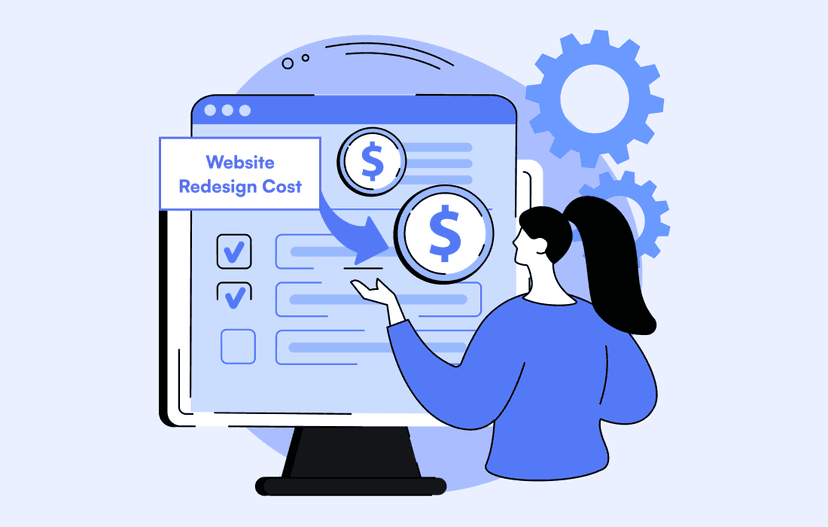Desktop App to Web App Migration: Cost, Process & ROI Explained
Migrating from a desktop app to a web app is no longer optional, it’s essential for scalability, cost savings, and global access. This guide walks you through the process, costs, timeline, and ROI so you can migrate confidently and future-proof your business.
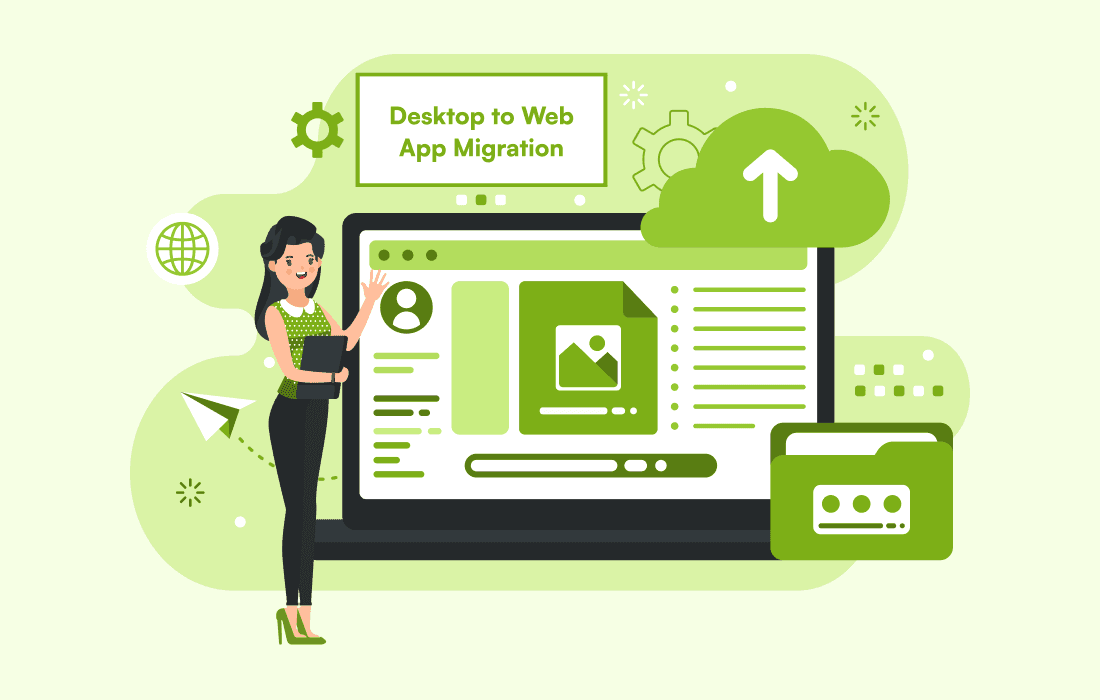
Your desktop app works fine – until your users start asking,
“Why can’t I access this from my phone or browser?”
That question points to you the bigger problem – today’s users demand on-the-go access, real-time updates, and frictionless collaboration.
Sticking to a desktop app locks you out of modern opportunities.
It keeps you chained to IT maintenance, and risks losing customers to more agile competitors.
That’s where the desktop app to web app migration comes in.
This guide will show you how to convert desktop apps to web apps (and vice versa when needed) – step by step – so you can migrate without data loss, downtime, or spiraling costs.
Table of Contents
What Is Desktop App to Web App Migration?
Desktop App to Web App Migration is the process of converting a traditional desktop application into a browser-based web application. This means your app becomes accessible anywhere, updates automatically, integrates with cloud services, and scales with your business.
Latest in 2025?
- The growing desktop app to web app migration trend has led to a reduced desktop user share by 38.53% (February 2023).
- Gartner predicts that by 2028, more than 50% of tech workloads will be working in the cloud environment. (Workload broadly referring to legacy desktop apps)
Both these stats indicate that the market is changing and moving towards web app adoption quickly.
This blog covers how to convert a desktop to a web app, plus insights on how to convert a web app to a desktop app when needed.
Desktop App vs. Web App: Core Differences & Decision Table
This quick comparison table shows the major differences between desktop apps and web apps on different parameters.
| Criteria | Desktop App | Web App | Best Fit For |
| Performance Needs | Heavy computation, offline usage, high-end hardware requirements | Cloud-based, scalable performance, works across devices | Desktop: Engineering, CAD, Gaming
Web: SaaS, eCommerce, Global apps |
| Deployment & Updates | Manual installs & updates (time-consuming) | Centralized, instant updates for all users | Web apps win for SaaS & frequent updates |
| Accessibility | Limited to installed devices | Anywhere, anytime with internet access | Web apps are ideal for remote teams & global users |
| Scalability | Hard to scale across users/devices | Easily scales with cloud infrastructure | Web apps for growing businesses |
| Security | Local data storage, risk of version mismatches | Centralized security, cloud backups, easier compliance (GDPR, HIPAA, PCI) | Web for compliance-heavy industries |
| Offline Usage | Works offline, independent of the internet | Limited offline capability (except PWA, caching) | Desktop for offline-critical apps |
| Maintenance & IT Costs | High (manual patching, IT staff dependency) | Lower (cloud-managed, automated updates) | Web apps reduce long-term costs |
| User Experience | Rich, hardware-integrated UX | Responsive, cross-device modern UX | Depends on user expectations |
When Desktop Works the Best: Offline-first industries, heavy local processing (e.g., video editing).
When Web Wins: Scalable SaaS, collaboration tools, global user base.
Decision Tree:

Here is a decision tree to help you with the query to convert a desktop app to a web app.
Why is Converting a Desktop App to a Web App Beneficial?
Following the trend is ok, but your business needs a strategic move when you know you have to modernize and stay ahead of competitors. Migrating from desktop to web app has its advantages, like –
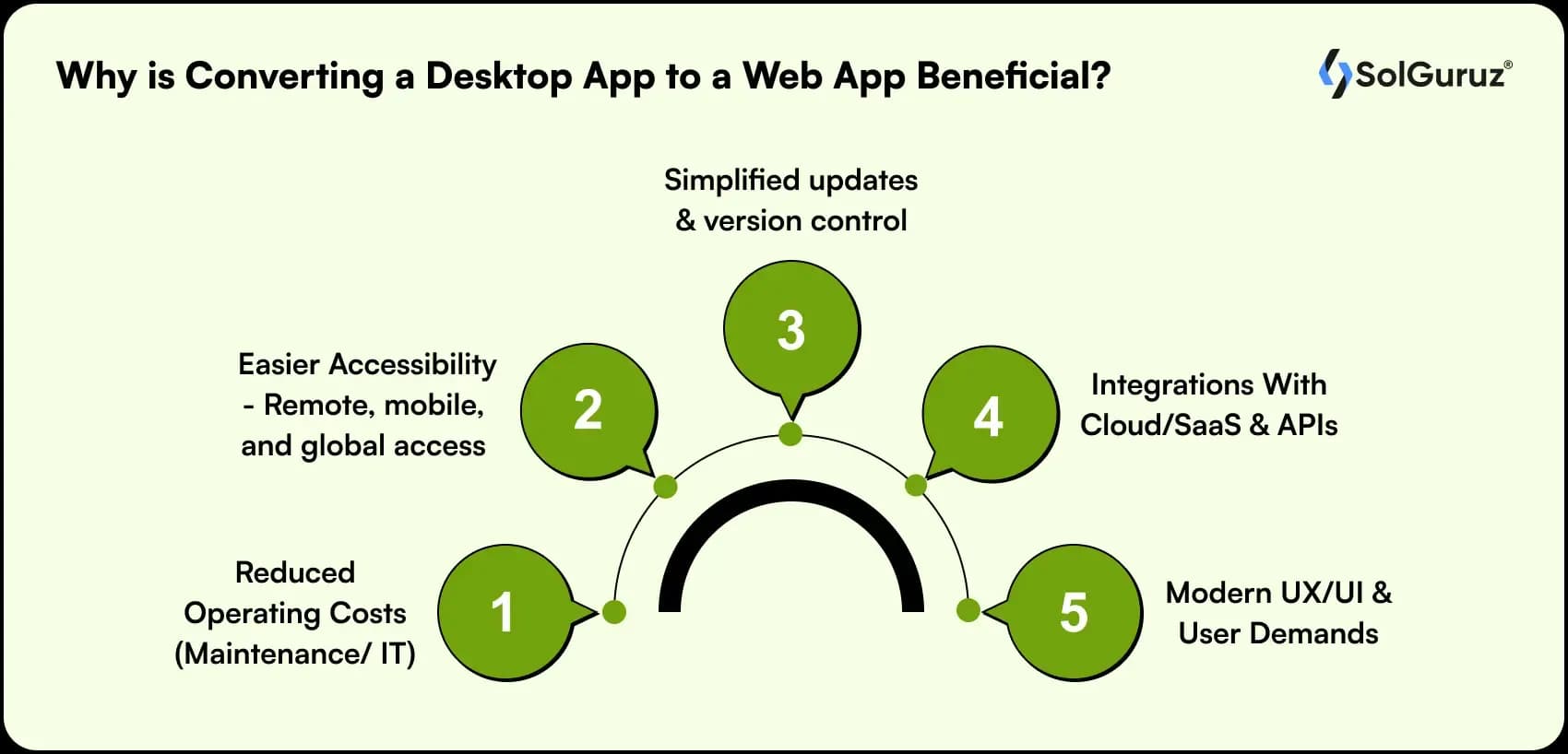
1. Reduced operating costs (maintenance/IT)
- No costly desktop installations and frequent updates. Splurging on new devices to boost the speed and per-visit charges.
- With centralized hosting, you can reduce the IT overhead charges.
- Cloud infra makes sure you pay for what you use. It makes things more predictable and growth easier.
2. Easier Accessibility – Remote, mobile, and global access
- You can access your data from anywhere in the world without depending on physical office presence.
- Expanding your reach to international businesses.
- Increased portability
3. Simplified updates and version control
- Uniformity – Updates are rolled out across all users.
- Saving memory with no unnecessary patch downloads or installs.
- Consistency- consistent performance all over.
4. Integrations with cloud/SaaS and APIs
- Web apps integrate effortlessly with CRMs, ERPs, or SaaS tools.
- Web apps allow automation and third-party extensions.
- Prepares your app for futuristic tech like AI/ML and others.
5. Modern UX/UI and user demands
- Web apps deliver responsive designs across devices(mobile, desktop, tablet).
- Intuitive navigation and fast interactions for users.
- Modern user experience makes your brand more competitive.
Check If You are Ready for Migration or Not?
Get your pre-migration readiness checklist to assess whether you are ready for the change.
Risk vs. Reward in Desktop-to-Web App Migration
This table shows the comparison of “what is the risk in the migration vs. what you will be rewarded if you convert from desktop to web app?”
| Risks | Impact | Rewards | Business Value |
| Data Loss or Corruption | High – critical if migration isn’t planned with backups | Data Centralization & Security | Stronger compliance (GDPR, HIPAA) & cloud resilience |
| Downtime During Migration | Medium – user disruption can cause dissatisfaction | Global Accessibility | Users can access from anywhere, anytime |
| Migration Costs | High upfront investment | Long-Term Cost Savings | Reduced IT support & faster updates |
| Performance Gaps | Medium – poorly optimized web apps may lag | Scalability & Flexibility | Handle global traffic with cloud scaling |
| Change Management (User Training) | Low to medium resistance from staff | Modern UX/UI | Better engagement, retention, and competitive edge |
The Desktop App to Web App Migration Process with SolGuruz: Step-by-Step Roadmap
Migrating from desktop to web app is not just a one-click method. It is a structured journey to ascertain that your app is modernized. Not just modernized, it is optimized for future scalability.
Many businesses have adopted this process to successfully migrate. Here is a seven-step process.
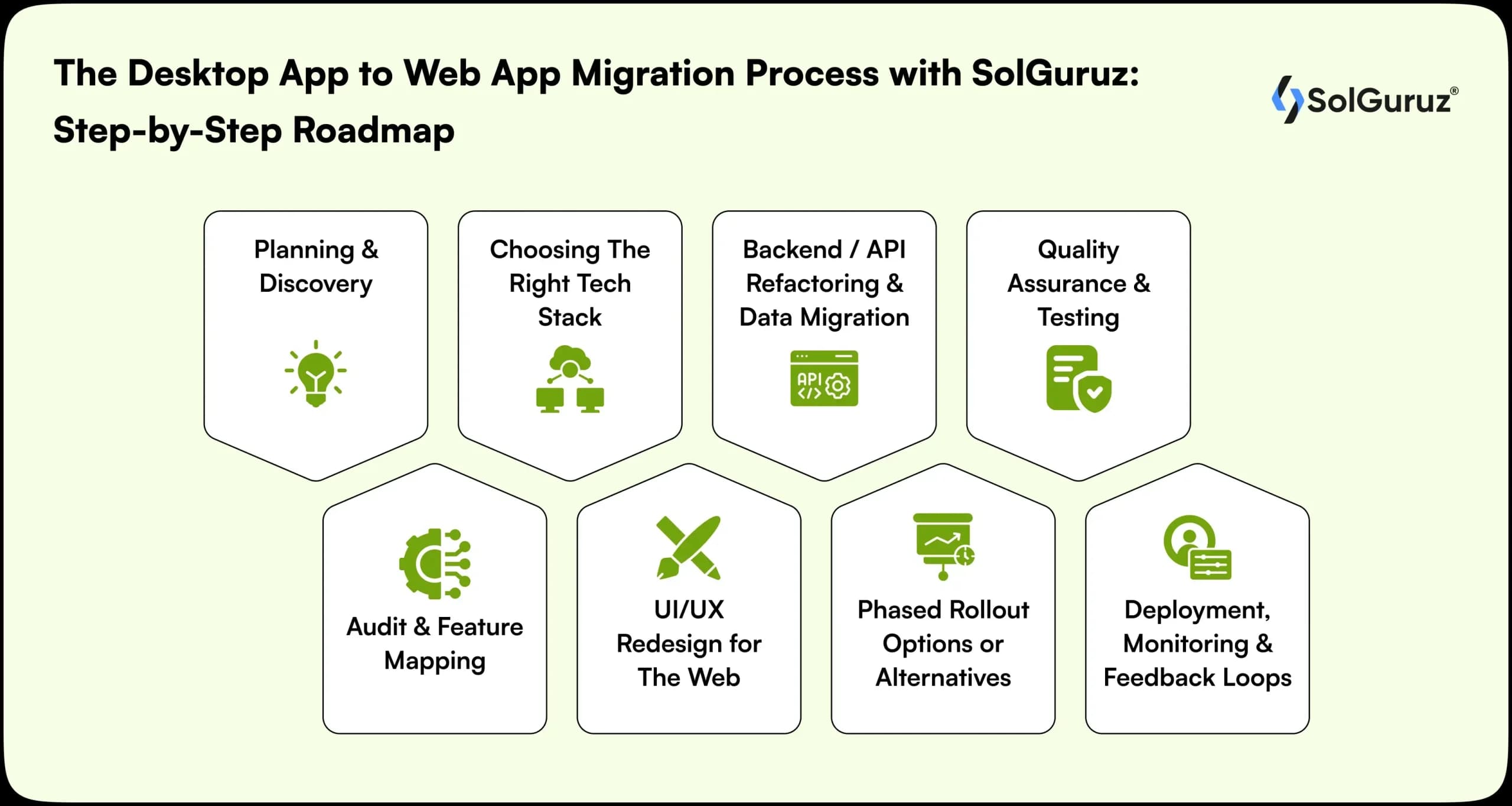
1. Planning & Discovery
Every smooth migration begins with effective planning. What you need, where you want to, and when. All such questions answer the core intent behind migration. It also gives the migration partner a clear understanding of your goals. What you can expect is –
- Gathering requirements about your business.
- Understanding current workflows, performance bottlenecks, and pain points.
- Assembling the right team to make the task successful. Allocating the right resources – developers, QA, project managers, and cloud infrastructure experts.
Pro tip: Save up to 20-30% of unexpected rework costs with a clear roadmap.
2. Audit and Feature Mapping
Since it is a migration of the existing system, an audit becomes necessary. Before writing a single line of code, we audit your existing desktop app:
- Identify which features are still relevant and which are not useful anymore.
- Map out critical dependencies such as third-party integrations, APIs, or legacy databases.
- Evaluate technical debt in the current system.
This step makes sure not to carry forward the current problems to the modernized system. It ensures you improve along the way!
3. Choosing the Right Tech Stack
Frameworks matter. Depending on your existing architecture and team expertise, you may choose. The right choice ensures faster development, scalability, and long-term maintainability.
(Refer to the section “Which Framework Will Work the Best for You?” to get detailed information about the tech stack — we’ve added the details below for your better understanding.)
4. UI/UX Redesign for the Web
A web app is not just a desktop app on a browser. It is much more than that. It needs a responsive, intuitive, and modern user experience. This step includes:
- Mobile-friendly layouts with appropriate UI/UX principles.
- Updated design systems and accessibility compliance.
- Simplified navigation for global audiences.
5. Backend/API Refactoring & Data Migration
One of the most critical phases of the whole process –
- Refactor backend services into scalable APIs.
- Migrate databases securely, ensuring no data loss.
- Integrate with existing legacy systems or cloud SaaS platforms.
Pro Tip – A skilled Legacy app modernization service can conduct this whole process with precision and zero data loss.
6. Phased Rollout Options or Alternatives
We understand every business can not afford downtime. For some, it’s not possible, and for some, it is not feasible. Here are common rollout strategies:
- Lift & Shift: Directly porting features with minimal changes (fast but limited).
- Full Rebuild: Re-engineering the app for the web (time-consuming but future-proof).
- Incremental Migration: Gradually moving modules while keeping the desktop version running.
These are different migration models that are used depending on the situation. You can always talk with your migration partner that which model will be the most beneficial for you.
Also, understand the whole process in advance to avoid any miscommunication later.
7. Quality Assurance & Testing
Testing ensures the new web app performs seamlessly. What you can expect in this step –
- QA for bugs and glitches.
- UAT (User Acceptance Testing) with real users.
- Regression testing to ensure existing workflows remain intact.
- Security testing to prevent breaches.
8. Deployment, Monitoring & Feedback Loops
Finally, your new web app is ready for launch. But the journey does not end here. There are more things like regular updates, bug fixes, and upgrades. You can see in this step –
- Continuous monitoring to track performance and user behavior.
- Regular feedback loops to refine features.
- Maintenance and security updates to keep your app future-ready.
With this roadmap, your desktop app to web app migration transforms from a technical task into a strategic digital upgrade.
Now the next question is “Which is the perfect tech stack for migration?” Let’s understand the answer.
Which Framework Will Work the Best for You?
One of the biggest questions during a desktop app to web app migration is:
“Which tech stack should we choose?”
The answer isn’t one-size-fits-all – it depends on your
existing app, team expertise, and long-term goals.
So to guide you, we have compiled a question-answer style guide for frameworks –
Question – “Which is the right framework for my migration journey?”
Answer –
Front-End Frameworks
- React.js → The go-to choice for building dynamic web panels and admin dashboards. With its component-based architecture, React.js makes it easy to maintain complex UIs and scale as your application grows. It’s widely adopted and integrates seamlessly with modern libraries and backend APIs. You can consult React developers to get your front-end development done quickly and efficiently.
- Next.js → Ideal for marketing websites or content-heavy platforms where SEO is critical. Next.js enhances React with server-side rendering (SSR) and static site generation (SSG), ensuring faster load times and better search engine rankings. Perfect when discoverability and performance are top priorities.
- Vue.js → Lightweight, easier learning curve, great for quick migrations or smaller apps.
- Angular → Best for large-scale enterprise apps with complex features and structured architecture.
Back-End Frameworks
- NestJS → A progressive Node.js framework built with TypeScript. NestJS brings a structured, modular architecture similar to Angular, making it perfect for enterprise-scale backend systems. It’s designed for scalability, maintainability, and supports microservices, GraphQL, and event-driven patterns out of the box.
- Node.js → Fast, scalable, and great for real-time features (chat, notifications). Ideal if your team knows JavaScript. An expert Node.js development company can help you complete your project effectively.
- Blazor → Lets you reuse C# skills to build web apps – excellent for teams already deep in .NET.
- .NET Core → Perfect if your desktop app was originally built with Microsoft technologies (C#/VB). Great for enterprise and security-heavy apps.
If You Want to Convert a Web App to a Desktop App –
Sometimes businesses want the flexibility of both worlds. In such situations, frameworks like Electron and Tauri help.
- Electron → Turns your web app into a desktop app (Windows/Mac/Linux). Used by Slack and VS Code.
- Tauri → Lightweight alternative to Electron, with smaller bundle sizes and better performance.
Mini Tech Stack Matchmaker Table
|
Current App/Team Setup |
Best Tech Choice for Migration |
Cloud Infra (Enterprise-Ready) |
Why? |
| Built on C# / .NET desktop | .NET Core or Blazor | Azure (best native .NET support), AWS | Minimal learning curve, smooth migration. |
| The team is strong in JavaScript | React (front-end) + Node.js (back-end) | AWS, GCP | Unified JS stack, faster builds. |
| Small-to-mid app, fast migration needed | Vue.js (front-end) + Node.js | AWS Lightsail, GCP App Engine | Lightweight, easy adoption. |
| Enterprise app with complex workflows | Angular (front-end) + .NET Core | Azure (enterprise security), AWS | Scalable, structured, secure. |
| Need cross-platform desktop + web | React + Electron / Tauri | AWS Amplify, GCP Firebase | One codebase, multiple platforms. |
| Focus on real-time features (chat, dashboards) | React/Vue + Node.js | AWS AppSync, GCP Pub/Sub, Azure SignalR | Event-driven, handles concurrency well. |
| Large-scale data-driven enterprise apps | Angular/React + Node.js or .NET Core | AWS (EC2, RDS, Lambda), Azure Cloud Services, GCP BigQuery | Strong integrations, performance-heavy. |
| Admin panels/dashboards | React.js (front-end) | AWS Amplify, Vercel, Azure Static Web Apps | Component-based, scalable, excellent for complex web UIs. |
| Marketing websites (SEO critical) | Next.js (front-end) | Vercel (native), AWS Amplify, Azure Static Web Apps | Server-side rendering + static generation for SEO and performance. |
| Enterprise-grade backend needing structure | NestJS (back-end) | AWS Lambda, Azure Functions, GCP Cloud Run | Modular, scalable, supports microservices & GraphQL |
Pro Tip: The “right” stack is not just about technology – it’s about your team’s expertise, app complexity, and future scalability goals. If you’re unsure, a migration expert can help you choose the perfect fit.
Why 90% Businesses Fail: Common Mistakes to Avoid
The major desktop to web migration issues are generally considered the conversion pitfalls. You should take care and avoid these common mistakes.
-
Data migration/compatibility pitfalls
Data is the backbone of your business. And it is the most vulnerable during migration.
Issue – Data loss during migration is the most common of all the conversion issues. It impacts the business very badly.
Solution – Conduct rigorous pre-migration audits and use automated tools. Keep checking and ensure the conversion has zero to no data loss.
-
Ignoring Performance Optimization
Desktop apps typically run as thick clients with dedicated resources, while web apps share server loads and depend on internet connectivity.
Issue: Businesses often skip performance tuning after migration. This can lead to laggy interfaces, which makes the users frustrated.
Solution: Optimize server-side APIs, leverage caching strategies. You can also conduct load testing to ensure a smooth, high-speed experience.
-
Overlooking Security Vulnerabilities
While desktop apps are relatively contained, web apps face the open internet. This exposes them to new risks every time.
Issue– Users can face weak authentication, poor encryption, or improper handling of sensitive data can open doors to breaches.
Solution – Adopt robust security measures like SSL/TLS encryption, OAuth 2.0 authentication, regular penetration testing, and compliance audits (GDPR, HIPAA, PCI-DSS). Check for SOC2 and ISO 27001 certification for SaaS migrations.
-
Skipping Real-World Testing
Issue – After so much testing with in-house QA, there is a risk of ignorance. You might skip the testing in a real-world environment.
Solution – Before rolling out fully, perform User Acceptance Testing(UAT) with users to get feedback.
Expert Insight –
“One of our clients underestimated how critical database mapping was. Midway through migration, they lost thousands of records due to schema mismatches. Fortunately, with a rollback plan and phased testing, we restored the data integrity and successfully migrated them to a scalable web solution.”
Senior Developer, SolGuruz
Also, refer to the “Risk vs. Reward table” to better understand the rewards you get when you avoid such challenges.
Now comes the long-awaited question: “ What is the cost to migrate from desktop to web app?”
Cost, Timeline, and ROI for Desktop App to Web App Migration
One of the first questions businesses ask –
“How much does it cost to convert a desktop app to a web app?”
The answer depends on the complexity of the app, the features included, and the long-term goals. Below is the cost breakdown table with parameters like cost, ROI, and approximate timeline.
| Migration Scope | Estimated Cost (USD) | Timeline | ROI Potential | Best Fit For |
| Simple App Migration (Basic utilities, limited features) | $8,000 – $20,000 | 2 – 3 months | 1.5x – 2x in 12 months (via reduced maintenance & cloud savings) | SMEs, startups with lightweight tools |
| Mid-Complexity Migration (ERP modules, CRM, industry-specific apps) | $20,000 – $60,000 | 3 – 6 months | 2x – 3x in 18 months (wider access, faster updates) | Growing businesses & SaaS providers |
| Enterprise-Level Migration (Legacy systems, large databases, multiple integrations) | $60,000 – $150,000+ | 6 – 12+ months | 3x – 5x in 24 months (scalability, global reach, security compliance) | Large enterprises & mission-critical apps |
Migration expense breakdown
When budgeting for migration, remember that costs are not just about coding. The cost comprises –
- Development & Refactoring – The cost of redeveloping the backend and rewriting the APIs.
- UI/UX Redesign – It includes the cost of creating modern and responsive interfaces. Intuitive interfaces often result in a great user experience.
- Cloud Infrastructure – The cost of hosting the platform. Also, add the cost of scalability if you want to grow your app into the future. And there are third-party services.
- Quality Assurance (QA) & Testing – Regression cost. Then there is the security cost, i.e., for implementing the security patches. It also includes the cost of testing the app in a real-world environment.
- Hidden/Unseen Costs– You cannot ignore hidden costs. We agree these are unseen, but they add up to a significant number. These include training teams, integration fixes, downtime management, and licensing fees.
How Long Does Desktop App to Web App Migration Take?
The timeline can be typically –
Simple apps with limited features can take up to 2-3 months to migrate.
Medium complexity apps can take 3-6 months to migrate. It depends on the complexity of apps.
Complex apps with extensive features can take up to 6-12 months to migrate. It includes migrating complex databases, as well as working with compliance.
ROI: How Much is It Worth?
Investing in a desktop to web app migration delivers long-term returns:
- Reduced maintenance costs.
- Faster updates and easier version control.
- Wider user base with remote and mobile access.
- Improved integrations with SaaS, APIs, and cloud-native services.
- Enhanced user experience, boosting retention and adoption rates.
Industries Benefiting the Most from Migration And Case Studies
Different industries benefit from migration, and here are the case studies
- Healthcare → Compliance + remote access
- Real Estate → Online Property Search + compliance
- FinTech → Security + real-time data
- EdTech → Scalability during peak sales
- SaaS → Faster updates and cloud adoption
Industry Relevant Case Studies
Here are some ways industries are taking advantage of migration. We have successfully worked with numerous industries. Here we have shown the example of two industries –
- Healthcare – Staffing System Migration
A mid-sized hospital migrated its desktop-based EMR and staff system to a secure web app on AWS Cloud. The result: 40% lower IT costs, HIPAA compliance, and remote access for doctors – boosting patient care and reducing downtime.
- Real Estate – Property Management Modernization
A property management firm shifted its legacy Windows app to a web-based SaaS platform with tenant portals and cloud integration.
Outcome: 60% less admin work, 35% more on-time rent payments, and higher tenant satisfaction.
Future Trends in Desktop App to Web App Migration (2025 and Beyond)
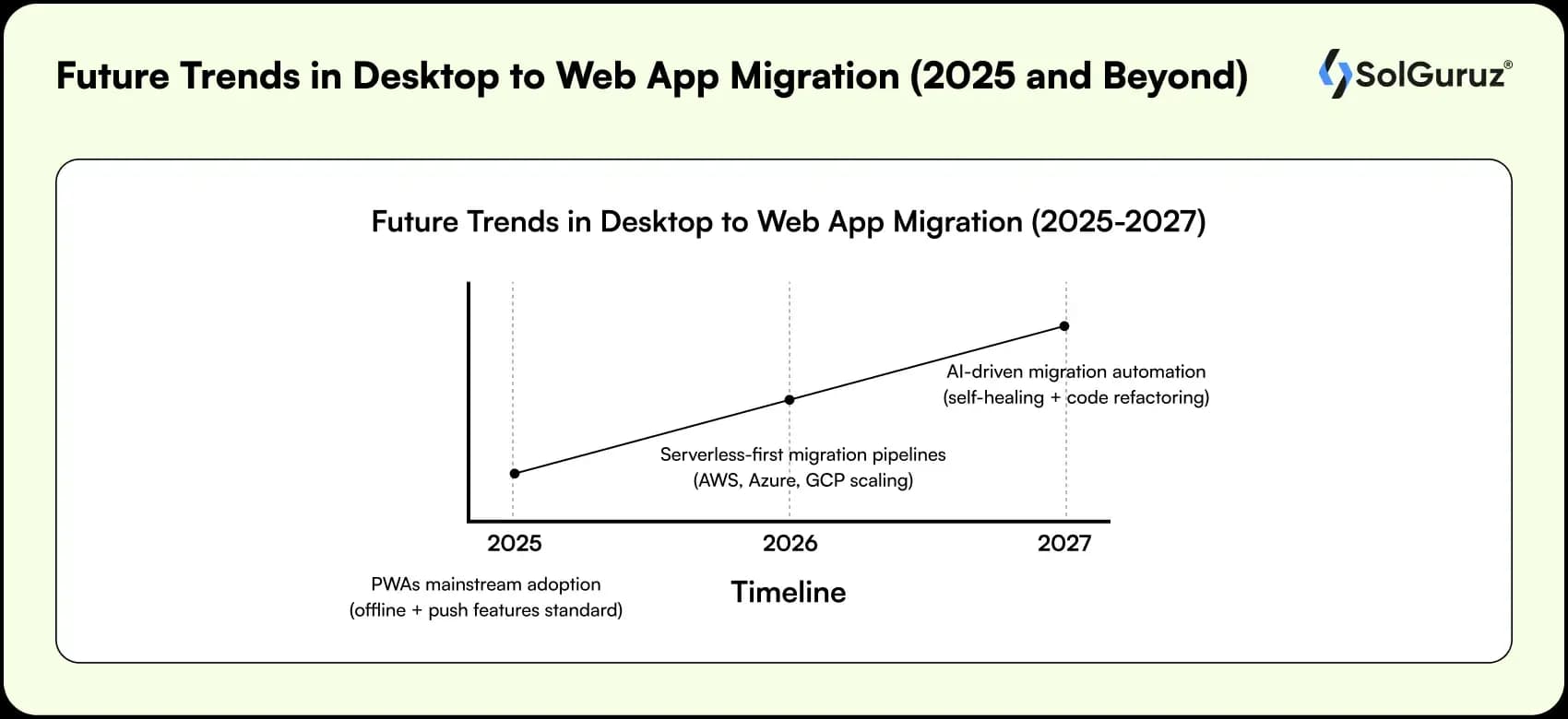
The way businesses migrate from desktop to web apps is evolving rapidly. If you’re planning migration in 2025, it’s not just about moving code – it’s about preparing for the next wave of digital transformation.
Here are the top trends shaping the future:
1. Progressive Web Apps (PWAs) for Hybrid Access
PWAs are bridging the gap between desktop and web. They allow users to install a web app on their device with offline support, push notifications, and native-like performance. It allows businesses to cut costs by maintaining one codebase that works across different devices like desktop, web, and mobile.
2. Serverless Architectures
Nowadays, more companies are shifting to serverless solutions (AWS Lambda, Azure Functions, GCP Cloud Functions) to reduce infrastructure costs and scale on demand. With faster deployments, reduced DevOps overhead, and pay-as-you-go efficiency, it works great for desktop to web app migration.
3. AI-Driven Migration Tools
Artificial Intelligence is now being used to automate parts of the migration process – from code refactoring to database mapping. AI agents can predict migration bottlenecks, suggest optimization paths, and even auto-generate responsive UI components. Tools like Crowd Botics, Pega Gen AI Blueprint, and others are very helpful.
4. Cloud-Native First Approach
Enterprises are prioritizing cloud-native development during migration. Features like containerization (Docker, Kubernetes) and multi-cloud strategies guarantee higher resilience, security, and vendor independence.
5. Security-First Migration Models
With stricter data compliance standards like GDPR, HIPAA, PCI DSS, SOC 2, and ISO, future migrations will be more secure. They will heavily focus on end-to-end encryption, Zero Trust models, and automated compliance checks baked into the migration pipeline.
Why Are Companies Choosing SolGuruz Over Others for Desktop App to Web App Migration?
At SolGuruz, we help businesses modernize legacy applications with secure, scalable, and cost-efficient migration strategies.
Why choose us?
- Proven expertise in desktop app to web app migration.
- End-to-end services from planning to post-launch support.
- Domain expertise across healthcare, real estate, fintech, and SaaS.
- AI-powered migration accelerators.
With SolGuruz, you won’t just migrate – you’ll future-proof your product.
FAQs
1. What is desktop to web app migration?
Desktop to web app migration is the process of converting traditional software built to run on local devices into a browser-accessible application. This allows users to access the app anytime, anywhere, without installing heavy software, while benefiting from cloud scalability, faster updates, and modern UX.
2. When is a desktop app better than a web app?
Desktop apps are better when:
- High-performance computing is needed (e.g., CAD software, video editing).
- Offline access is critical, and the internet isn’t always reliable.
- Hardware-level integrations (printers, scanners, IoT) are required.
- Heavy graphics or processing tasks that rely on local machine resources.
For most modern use cases (business, SaaS, real estate, eCommerce, healthcare), web apps are now preferred.
3. Can you migrate any desktop app?
In most cases, yes. However, the migration depends on:
- The complexity of the app (legacy code, outdated frameworks).
- The dependencies.
- The compliance with HIPAA, GDPR, and PCI.
Some legacy apps may need a partial rebuild instead of a direct migration. The key is assessing technical debt and deciding between different models.
4. What is the best tech stack for migration?
The best stack depends on your current architecture and future goals:
- Front-End: React Native, Angular, or Vue (responsive & modern UI).
- Back-End: Node.js, Blazor, or Django.
For detailed information, refer to the “Which Framework is the Best” section.
5. How long does a desktop to web app migration take?
Timelines vary based on complexity:
- Simple apps – 2–3 months
- Mid-complexity apps – 3–6 months
- Enterprise-level apps – 6–12+ months
Factors affecting time: data migration, integrations, UX redesign, compliance testing, and rollout strategy.
Written by
Lokesh Dudhat
Lokesh Dudhat is the Co-Founder and Chief Technology Officer at SolGuruz, where he leads the engineering team with deep technical insight and a builder’s mindset. With 15+ years of experience in full-stack software development, Lokesh has architected and delivered robust digital solutions for both startups and enterprises around the world. Lokesh is known for his hands-on expertise in developing scalable products using technologies like iOS, Android, Node.js, Python, PostgreSQL, MongoDB, Angular, RTC, AWS, and more. He plays a key role in shaping technical strategy, building engineering culture, and driving architectural decisions for complex projects. At SolGuruz, Lokesh works closely with clients during the discovery, MVP, and scale-up phases, helping them choose the right tech stack and engineering practices to achieve speed, stability, and long-term success.
Ready to Modernize?
Migrate your desktop app to the web with zero data loss.

1 Week Risk-Free Trial

Strict NDA

Flexible Engagement Models
Give us a call now!

+1 (724) 577-7737
